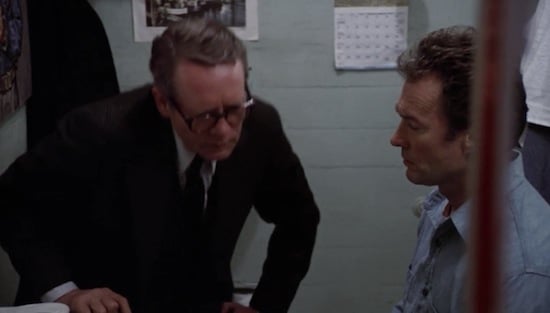Shocking Blocking (46)
By:
May 24, 2013

Like James Cameron’s Titanic, the plot of Escape from Alcatraz is merely a nerd’s excuse to squire viewers around every inch of an impressively constructed human-container. However, because there were no CD-Roms in 1979, perhaps we can be slightly more forgiving of Don Siegel; what’s Cameron’s excuse? I enjoy Alcatraz, but not because of its plot or any of the performances; rather, it’s because I enjoy the theme of existential and epistemological jailbreak in the oeuvre of creative types — from postmoderist theorists to this movie’s two stars, Clint Eastwood and Patrick McGoohan — who were born between 1924–1933. As I’ve proposed elsewhere, members of this cohort were a “silent” generation only in the sense that at some level they recognized themselves as inmates in a prison with invisible bars… and they were silently determined to tunnel their way to freedom. This movie literalizes the invisible-prison metaphor in a ham-fisted manner, to be sure; but the blocking in the odd scene shown here — the Warden, whom at least some viewers at the time would have recognized as the creator and star of the 1967–68 British TV show The Prisoner, squeezes into jailbreak artist Frank Morris’s tiny cell for a not entirely unpleasant chat — conveys a particularly subtle notion. In what Foucault called (in 1975) a “disciplinary society,” the distinction between the inside and the outside of a prison ceases to be a meaningful one. For captive and captor alike, there is no escape.
An occasional series analyzing some of the author’s favorite moments in the positioning or movement of actors in a movie.
THIRTIES (1934–1943): It Happened One Night (1934) | The Man Who Knew Too Much (1934) | The Guv’nor (1935) | The 39 Steps (1935) | Young and Innocent (1937) | The Lady Vanishes (1938) | Mr. Smith Goes to Washington (1939) | The Big Sleep (1939) | The Little Princess (1939) | Gone With the Wind (1939) | His Girl Friday (1940)
FORTIES (1944–1953): The Diary of a Chambermaid (1946) | The Asphalt Jungle (1950) | The African Queen (1951)
FIFTIES (1954–1963): A Bucket of Blood (1959) | Beach Party (1963)
SIXTIES (1964–1973): For Those Who Think Young (1964) | Thunderball (1965) | Clambake (1967) | Bonnie and Clyde (1967) | Madigan (1968) | Wild in the Streets (1968) | Barbarella (1968) | Harold and Maude (1971) | The Mack (1973) | The Long Goodbye (1973)
SEVENTIES (1974–1983): Les Valseuses (1974) | Eraserhead (1976) | The Bad News Bears (1976) | Breaking Away (1979) | Rock’n’Roll High School (1979) | Escape from Alcatraz (1979) | Apocalypse Now (1979) | Caddyshack (1980) | Stripes (1981) | Blade Runner (1982) | Tender Mercies (1983) | Monty Python’s The Meaning of Life (1983)
EIGHTIES (1984–1993): Repo Man (1984) | Buckaroo Banzai (1984) | Raising Arizona (1987) | RoboCop (1987) | Goodfellas (1990) | Candyman (1992) | Dazed and Confused (1993) |
NINETIES (1994–2003): Pulp Fiction (1994) | The Fifth Element (1997)
OUGHTS (2004–13): Nacho Libre (2006) | District 9 (2009)
Joshua Glenn’s books include UNBORED: THE ESSENTIAL FIELD GUIDE TO SERIOUS FUN (with Elizabeth Foy Larsen); and SIGNIFICANT OBJECTS: 100 EXTRAORDINARY STORIES ABOUT ORDINARY THINGS (with Rob Walker).
